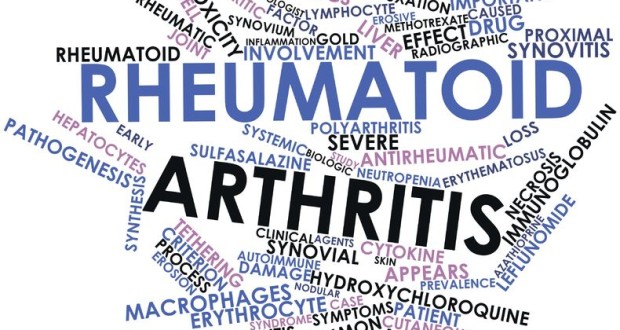When the term “arthritis” is mentioned, most people think of the common joint pains caused by the wear and tear of aging. And to be sure, in most cases this is an accurate perception. In 2005, an estimated 27 million Americans had osteoarthritis, a malady in which arthritic pain is caused by deteriorating joint cartilage. Osteoarthritis, however, should not be confused with rheumatoid arthritis (RA), as there are notable differences between these two conditions.
An Inflammatory Problem
Unlike osteoarthritis, the culprit behind rheumatoid arthritis is the body’s own defense system. The trouble starts when the immune systems starts attacking tissues near the joint area. Specifically, the body zeroes in on the synovium, a very thin layer of tissue found adjacent to the joint. Consequentially, the synovium becomes swollen and inflamed, growing to an abnormal size.
This inflammation has a ripple effect on the other tissues surrounding the joint, as the nearby tendons and ligaments are pulled and weakened. Furthermore, the cartilage that buffers the two bones begins to erode, forcing the bones to grind against each other in a very painful manner. Eventually, the persistent joint inflammation can wear away the bones themselves. At its apex, rheumatoid arthritis leaves joints enlarged and extremely sensitive, making them very uncomfortable to move.
The symptoms caused by rheumatoid arthritis don’t follow a steady and continuous pattern. Rather, they tend to wax and wane, disappearing for a while before returning with a vengeance. The periods of time when the disease is active are known as flares. For many people, rheumatoid arthritis originates in the small joints of the hands, feet and wrists. Stiff joints and nagging pain are usually the first signs that something is amiss. When the disease strikes the hands, opening doors and jars becomes especially difficult. Conversely, swollen joints in the feet can make walking exceptionally painful.
Over time, rheumatoid arthritis often makes its way through the body’s extremities, spreading to the ankles, knees, elbows and shoulders. It’s not uncommon for the hip joints to also be affected. These recurring bouts of inflammation can take a heavy toll on the afflicted joints, corroding and shifting their bones and tissues. As a result, the joints themselves become visibly deformed.
A Long List of Symptoms
The damage caused by rheumatoid arthritis isn’t limited to the body’s joints. This disease may also strike the linings of the lungs, leading to multiple respiratory problems. Because of this lung inflammation, some RA patients experience shortness of breath, frequent bouts of coughing and chest pains after taking deep breaths.
Another organ that may be attacked by RA is the heart. The heart is encased by a stabilizing layer of tissue known as the pericardium, which holds the organ in place and prevents it from expanding beyond its normal size. When the pericardium is inflamed, the patient can experience pain in the chest area, especially when lying down or leaning forward. More alarmingly, a person’s risk of heart attack increases sharply following the onset of rheumatoid arthritis. A 2010 Swedish study found that patients with RA faced a 60% higher risk of heart attack just one year after receiving their diagnosis.
Other health-related complications from rheumatoid arthritis include osteoporosis and carpal tunnel syndrome. In the case of the former, either RA or the medications used to treat it might lead to weakening of the bones. If the wrist joints are stricken with RA, the nerves in the patient’s wrist might be compressed by repeated waves of inflammation, causing carpal tunnel syndrome to develop.
Treatment Options for Patients
Unfortunately, medical science has yet to find a cure for rheumatoid arthritis. Making treatment even more of a challenge is that serious side effects are a common feature of many RA medications. For first-line treatments, doctors usually turn to medicines with relatively few side effects. In keeping with this approach, the patient may first be prescribed over-the-counter NSAIDs (nonsteroidal anti-inflammatory drugs). This class of medications includes aspirin, ibuprofen, and naproxen.
Should this strategy prove ineffective, stronger options that might be used include corticosteroids and DMARDs. Corticosteroids can be taken orally or through direct injection into swollen tissues. These drugs pack more of a punch than NSAIDs, and can be very effective in alleviating severe flares. This relief comes at a price, however, as corticosteroids may cause weight gain, eye cataracts and bone thinning. Additionally, the patient may also develop diabetes. Because of corticosteroids’ side effects, doctors usually give them to patients for only a short amount of time.
DMARDs, or disease-modifying antirheumatic drugs, are another type of second-line medication that can have a major impact on the body. DMARDs work to put the brakes on an overactive immune system, thereby reducing the amount of inflammation suffered by the patient. In a best case scenario, the patient’s level of pain is noticeably reduced, and the afflicted joints are spared from permanent damage.
According to the Agency for Healthcare Research and Quality (AHRQ), DMARDs can be divided into two distinct categories: nonbiologic and biologic DMARDs. Nonbiologic DMARDs are created using various chemicals. In contrast, biologic DMARDs and made with synthetic proteins, which are similar to the proteins made naturally by the human body.
Despite their potential benefits, DMARDs can induce numerous side effects on the patient’s body, some of which can be fairly serious. In order to clearly outline the risks of both nonbiologic and biologic DMARDs, the AHRQ has produced the following lists of possible side effects (all data was taken from warning labels issued by the US Food and Drug Administration. The proceeding nformation can also be viewed at this link: http://effectivehealthcare.ahrq.gov/search-for-guides-reviews-and-reports/?pageaction=displayproduct&productID=1314).
Nonbiologic DMARDs Possible Side Effects
- Upset stomach
- Nausea
- Diarrhea
- Hair loss
- Mouth sores
- Rash or serious skin reactions
- Liver, kidney, or lung problems
Biologic DMARDs Possible Side Effects
- Redness, swelling, itching, bruising, or pain in the area where the shot was given
- Sinus infection (sore throat, runny nose, hoarseness)
- Headache
- Nausea
- Diarrhea
Possible Serious Side Effects
- In rare cases, the nonbiologic DMARD methotrexate and some biologic DMARDs (including adalimumab [Humira®], etanercept [Enbrel®], golimumab [Simponi®], and infliximab [Remicade®]) have been associated with:
- Serious infections such as tuberculosis (called “TB”), fungal infections such as yeast, pneumonia, or food-borne illnesses such as listeria
- Cancer, usually lymphoma (cancer in the lymph glands, which are part of the immune system)
- The risk of serious infections or cancer is increased by taking two or more biologic DMARDs together or by taking a biologic DMARD with a nonbiologic DMARD. The exact risk to people with RA who are taking a DMARD is not known.
- Rituximab (Rituxan®) can cause a severe reaction the first time you take it. It could also cause a life-threatening rash.
 Natural Knowledge 24/7 Educate yourself with nutrition, health and fitness knowledge.
Natural Knowledge 24/7 Educate yourself with nutrition, health and fitness knowledge.






